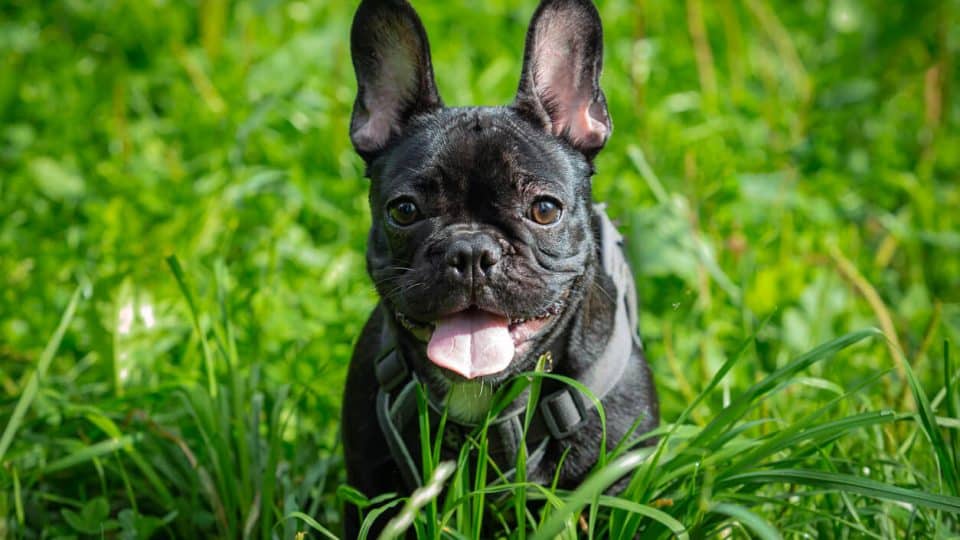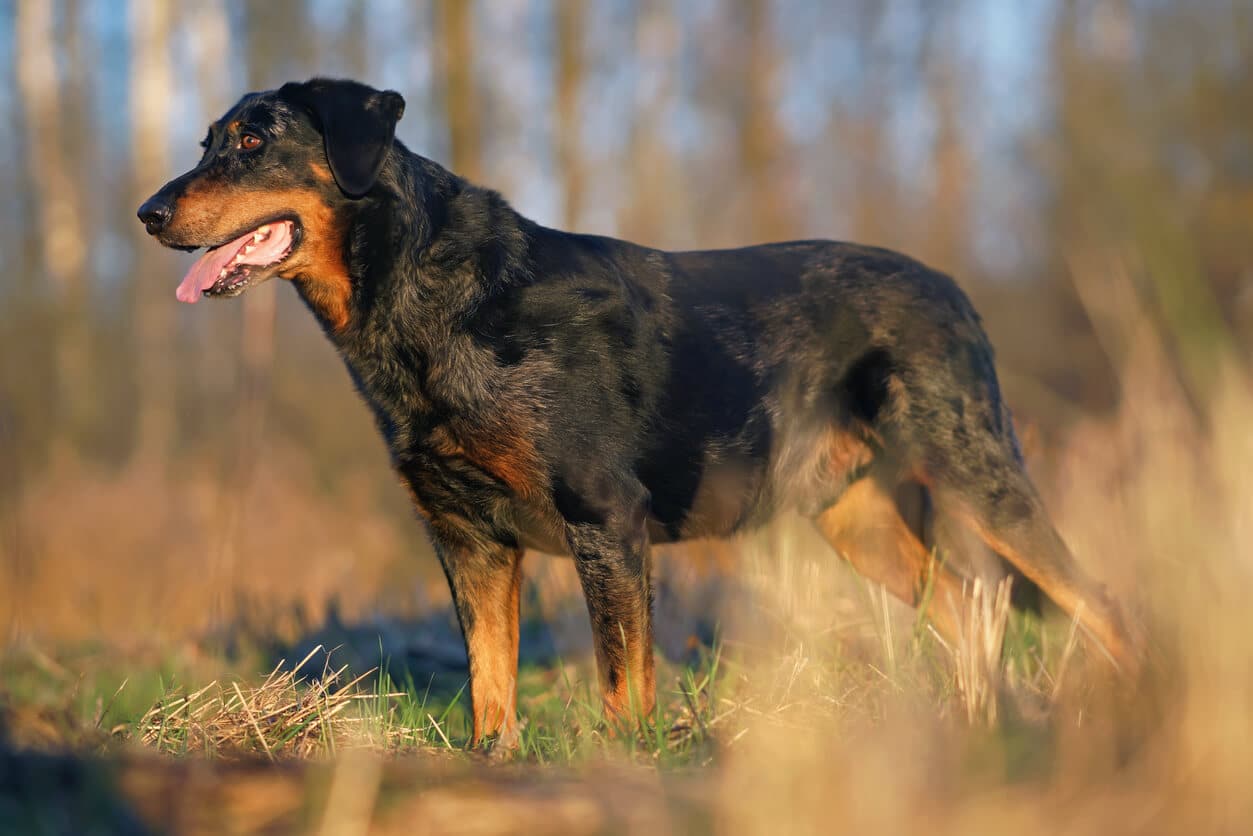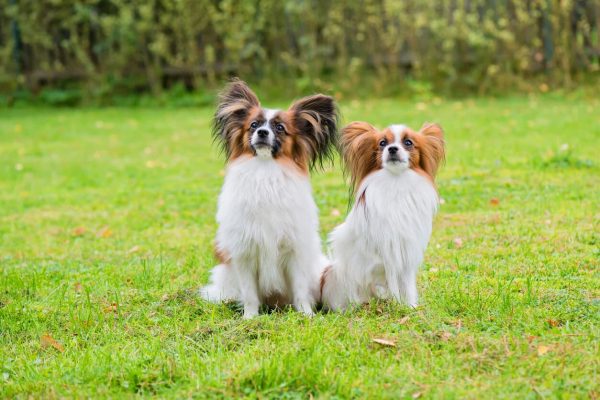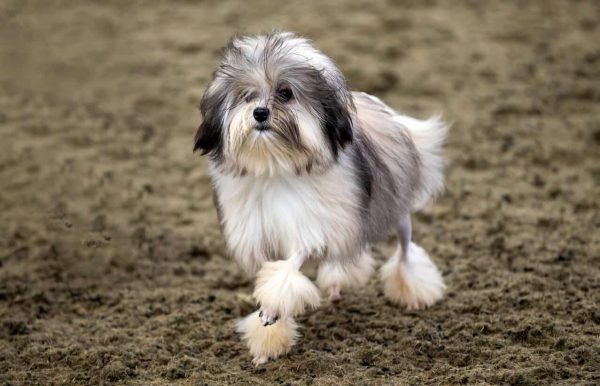- Not a substitute for professional veterinary help.
France is famous for many things: fashion, cuisine, monuments like the Eiffel Tower—and of course, French dog breeds.
More than 50 dog breeds originated in France, including the Papillon, the French Bulldog, and the Beauceron. Dogs are fairly popular in France, too: Around 20% of French households have a dog, or chien.
French dog breeds have captured the hearts of Americans, too. In fact, the French Bulldog has numbered among the top 10 most popular dog breeds in the U.S. for the last few years.
Below, we’ll highlight some of France’s most famous dogs, including the the oldest, most popular, rarest, and the most expensive breeds!
Oldest Dog Breeds from France
Several ancient French breeds still exist today.
Dogue de Bordeaux
The Dogue de Bordeaux, or French Mastiff, is one of France’s oldest breeds.
This Mastiff-type dog was originally bred to guard vineyards in France, according to Angie Reed, President of Dogue de Bordeaux Society of America. These dogs also had other jobs, including boar hunting and fighting.
As a guardian breed, these dogs are happiest when around people, Reed says. ”This is not the breed to leave in the backyard alone.”
She adds that socialization is very important for this breed. “For a well-balanced Bordeaux, you must introduce your dog to many different things in life.”
If you’re about to bring a Dogue de Bordeaux home, don’t forget to stock up on yummy dog treats. “Rewards can be food or praise, depending on the dog, but they always want to please you and be with you as much as possible,” Reed explains.
Berger Picard
The Berger Picard, also known as the Picardy Shepherd, is one of the oldest French sheepdog breeds. These dogs first came to northern France around 400 BCE. The breed almost became extinct after World War II and remains relatively rare today.
These dogs feature in many medieval tapestries and woodcuts. They have an appearance many people describe as “rustic,” with a shaggy coat and erect ears.
The Berger Picard is a highly intelligent dog, and the breed still has a strong herding instinct. They’re loyal to their people but can be reserved with strangers, which makes early socialization even more important.
Barbet
The Barbet is a rare French water dog with a history dating back to the 16th century. They’re considered ancestors to several modern breeds, like the Bichon Frise. The breed’s name comes from the French word “barbe,” meaning beard, in reflection of its distinctive facial hair.
Barbets are both adorable and functional. Ellen Rich, AKC Breeder of Merit, at Ethelred Barbet, describes Barbets as joyful, loving, and intelligent dogs. Historically, they were versatile gun dogs who played an important role in hunting waterfowl.
“The Barbet is a newly AKC recognized breed,” Rich explains, adding that they’re gaining popularity due to their personality, low-shedding coats, and medium size.
Beauceron
The Beauceron, also known as the Berger de Beauce, is a French breed dating back to the 16th century. This large, well-muscled dog has a short, dense coat, typically in black and tan, and distinctive double dewclaws on the hind legs.
“Beaucerons are first and foremost sheep herding dogs,” says Kara Staroski from Nightwalk Beaucerons in Connecticut. She adds that they have a long history as versatile, all-purpose farm dogs.
“Beaucerons are really unique as far as personalities go. With their families, they are incredibly devoted, silly, and biddable,” Staroski says. She adds that they have very high energy and intelligence, which makes them a great fit for active people who enjoy dog sports and training.
“It would be a struggle for the family looking for a couch potato pup to keep a Beauce happy,” she says.
Great Pyrenees
The ancestors of the Great Pyrenees first came to the Pyrenees Mountains around 3000 BCE, where they were bred to guard livestock. People quickly began to recognize the breed for their protective instincts and majestic appearance. In 1675, the court of King Louis XIV adopted the Great Pyrenees as the Royal Dog of France.
The Great Pyrenees has a very thick, weather-resistant coat and large, powerful body. Despite their size, they’re known for their calm and gentle natures—especially when they get enough exercise. These dogs still work as livestock guardians, but plenty of people also keep them as pets.
Most Popular Dog Breeds from France
French dog breeds have captured hearts around the world. Here are some of the most well-known French dogs.
French Bulldog
The French Bulldog originated in the 19th century when small English Bulldogs were imported into France. After that, they quickly became popular in Paris among writers and artists. They’ve recently skyrocketed in popularity in the U.S., ranking in the top 10 most popular dogs for several years in a row.
These compact and muscular dogs have bat-like ears and short snouts. They have affectionate and adaptable natures, and they make excellent companions for both city and country dwellers—not to mention great apartment dogs.
Basset Hound
The Basset Hound originated in France in the sixth century. Experts believed they descended from the St. Hubert Hound.
They were bred as hunters, as their small stature makes them very good at tracking small game scents on the ground. Their long, droopy ears also help stir up scents, improving their tracking abilities.
Though some people still keep Basset Hounds as hunting dogs, many Basset Hounds today live as cherished family pets. These laid-back and gentle dogs do very well with children.
Bloodhound
Bloodhounds can also trace their lineage to the St. Hubert Hound. This breed originated in France in the seventh century.
They’re known for their tracking abilities—they have the strongest sense of smell among dogs. They worked as game trackers in the Middle Ages, and today, they also work as search and rescue dogs. Their large and agile bodies help them them track more effectively.
Bloodhounds have loose skin and long ears. They are gentle and affectionate but determined when they catch a scent trail, and this determination can mean they’re prone to wandering off! With socialization and enrichment, they make great family dogs.
Papillon
This breed descended from the Continental Toy Spaniel and adopted their new name in 19th century. Their name comes from their large, butterfly-like ears—“papillon” means butterfly in French. Both France and Belgium consider this elegant breed native to their countries.
Papillons were originally bred as companion animals, and they’re friendly and highly trainable. They thrive in homes where they can explore the outside world. They do well at agility tasks, and their intelligence also helps them succeed in obedience competitions.
Rarest Dog Breeds from France
Not all dog breeds from France have become known around the world. However, some of the lesser-known breeds are gaining recognition in the U.S. and worldwide.
Löwchen
The Löwchen has been a beloved companion across Europe for over 500 years. No one knows for certain where the breed originated, but one theory suggests the breed developed in Northern Europe, the area now divided into France, Germany, and Belgium.
The Löwchen is a small, sturdy breed. These dogs have a distinctive flowing mane and resemble lions with the traditional breed haircut. That’s how they get their name, in fact: Löwchen means “little lion” in German.
They have affectionate and lively natures that make them great companion animals, and breeders are working to preserve this rare breed.
Pont-Audemer Spaniel
This spaniel originated in the 19th century in the Pont-Audemer region of France, most likely as a cross of Irish and English Water Spaniels.
Waterfowl hunters favored them due to their prowess in marshy terrain. They have curly, waterproof coats that help protect them from the elements as they work.
Today, the breed is extremely rare, with only about 200 dogs left worldwide. They’re energetic and affectionate dogs that tend to be gentle at home but enthusiastic on hunting trips!
Braque du Bourbonnais
One of France’s oldest pointing breeds, the Braque du Bourbonnais dates back to the Renaissance. These dogs were first bred in the Bourbonnais region and celebrated for their hunting skills. The breed faced near extinction in the mid-20th century, but breeders are slowly bringing these dogs back.
Barques tend to be eager to please, versatile, and intelligent dogs, which makes training them a pretty straightforward process! Many people still use them as pointing dogs when hunting game, and they also excel in field trials.
Artois Hound
The Artois Hound hails from the Artois region of northern France, where they were bred in the 15th century as scent trackers. Historically, the French nobility favored these dogs for their skill at hunting hares.
The breed nearly vanished after World War II, but dedicated efforts helped bring these dogs back into existence. Enthusiasts cherish these loyal dogs for both their hunting abilities and their companionship.
These hounds have a tricolor coat and a very keen sense of smell. They’re very energetic, need regular exercise and mental stimulation, and can’t be left alone for long periods of time. They do best with experienced and involved dog parents.
Grand Bleu de Gascogne
The Grand Bleu de Gascogne also descends from the St. Hubert Hound. They were first bred in the Gascony region as large game hunters, and they still work as tracking dogs.
This breed has a distinctive mottled blue coat. They’re gentle, patient, and devoted dogs who need space to run and regular exercise.
Petit Basset Griffon Vendéen (PBGV)
The Petit Basset Griffon Vendéen is the smallest of the Griffon Vendéen hounds. These dogs originated in the Vendée region of France in the 16th century as small game hunters. The PBGV gained recognition as a distinct breed in the 1950s and became popular in the U.S. toward the end of the 20th century.
The breed has a rough, wiry coat and smaller body. These cheerful, energetic dogs need plenty of daily exercise! They enjoy being part of a family and need consistent attention. With enough activity, they make good family dogs. They also tend to excel in many different dog sports.
Most Expensive Dog Breeds from France
Some French dog breeds can be quite expensive. Some breeds cost more because of high demand, while others have a hefty price tag due to their rarity. Here’s what you can expect to pay for some of the priciest French dogs:
- French Bulldog: The price of a Frenchie can vary widely, depending on their color and the breeder. Standard colors often range from $1,500-$4,000. Puppies with rare coat colors, like blue and merle, may cost more than $5,000. Both high demand for the breed and breeding difficulties contribute to the high price. Most Frenchies require artificial insemination and C-sections, which are costly.
- Barbet: According to Rich, you’ll pay about $4,500 for a well-bred Barbet, and both of the puppy’s parents should have completed the recommended health testing.
- Löwchen: The Löwchen is a rarer dog, which drives the price up. Puppies generally cost between $2,500-$4,500. Since many breeders funnel their puppies into show and breeding programs, you may have a harder time finding a companion puppy. Certain breeders may even require all dogs be bred or shown.
- Dogue de Bordeaux: “Show quality dogs can cost up to $5,000, and good pet quality dogs can cost around $2,500. I always suggest looking at a rescue first and foremost,” Reed recommends.
- Braque du Bourbonnais: Due to their rarity, a Braque du Bourbonnais puppy may cost more than $2,000. In some cases, you may be able to get a discounted rate if you plan to breed or show your puppy.
- Beauceron: Staroski says Beaucerons typically cost between $2,500-$3,500, since they’re so rare.
When considering the cost of your puppy, it’s also important to keep in mind the other costs of dog parenthood!
Before committing to adding a dog to your life, you’ll want to budget for food, training costs, leashes and other gear, annual vet visits, and other expenses.
Active dogs—like many of the French dog breeds mentioned here—benefit from multiple walks a day. With Rover, you can connect with background-checked professionals in your area who offer personalized care tailored to your dog’s needs.








